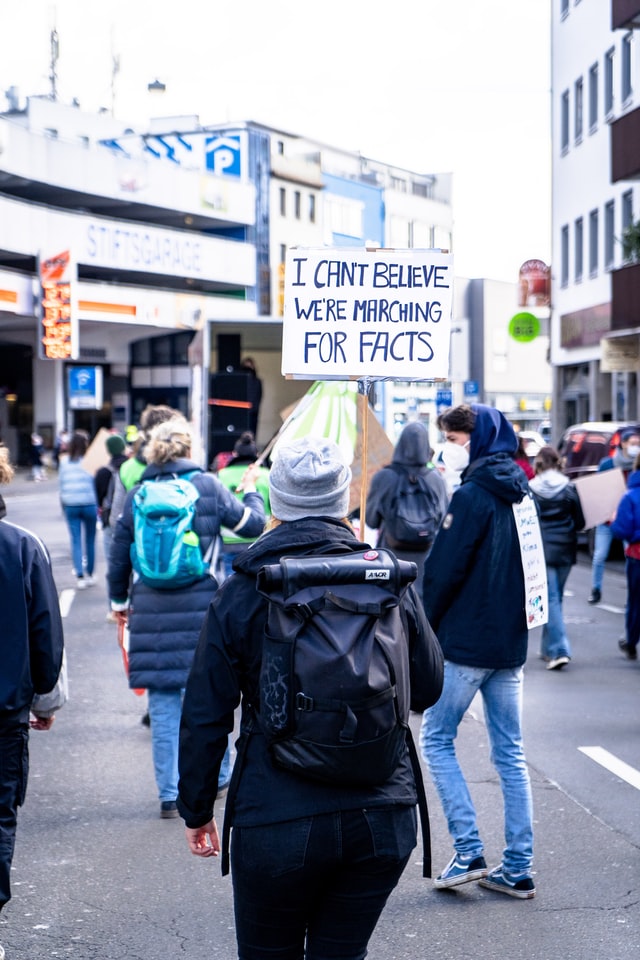
The Hostile Environment(alists)
Article by Tamar Singer
Photo by Mika Baumeister on Unsplash
Walking along Oxford Road, or through many similar university campuses, political posters are commonplace. Recently, one particular poster design has appeared: a stylised outline of a skull above the line “bit.ly/3billionrefugees” repeated 5 times. This links to a video and refers to the (methodologically questionable) statistic that over 3 billion people may be forced to migrate in the near future due to the climate crisis[1]. Slogans and headlines such as this, using the ‘threat’ of large numbers of migrants to scare observers into action, are not uncommon. However, these narratives are ultimately antithetical to a climate movement that advocates for justice.
The mainstream climate movement in the UK, and much of the Global North, is overwhelmingly focused on the urgent need to reduce emissions. Whilst this is obviously essential, there is a lack of recognition of the fact that even if emissions dropped to zero overnight some continued climate change is already inevitable[2]. Adaptation to this newly unstable world is as key as mitigating worse effects, and the climate movement must develop a clear set of demands and take grassroots action around this. But what does climate resilience look like for countries like the UK, which will experience far from the worst impacts of the climate crisis? For one thing, it means opening our borders and creating a society that welcomes and provides for immigrants[3]. Considering the current state of immigration policy and mainstream discourse, this requires a radical transformation.
The term ‘hostile environment’, describing a set of policies that aims to make life as tough as possible for undocumented immigrants, was coined by then-Home Secretary Theresa May in 2012, but the origins of this government strategy are seen earlier. From the 1968 Commonwealth Immigrants Act to New Labour’s expansion of detention centres[4], the last half century has seen many measures introduced to make life harder for immigrants, and the mainstream narrative has increasingly shifted to one of ‘controlling our borders’. Nowadays, there is a web of punitive practices across our public services which criminalise migrants and make it dangerous to access healthcare, education, housing and other necessities of life[5][6]. Migrants of Colour often face the sharpest end of this inhumane treatment, as seen with the Windrush Scandal[7]. These groups are also the most likely to be hardest hit by the climate crisis because of a combination of geographical factors and high levels of poverty (due to histories of colonisation and contemporary exploitation), limiting their ability to cope with disasters. This is further exacerbated by unstable political systems in many previously colonised countries and environmental racism in the Global North.
When the climate movement uses standalone statistics such as ‘3 billion refugees’, they reinforce the narrative that we should be scared of ’dangerous invasions’ of immigrants. The fact that people’s homes become uninhabitable is horrific, but framing it like this portrays the population into which people are migrating as the victims, and dehumanises the people themselves. This is the story already told by the majority of mainstream media[8] and politicians and only serves to legitimise the inhumane treatment of migrants. Fundamentally, the climate movement aims to create a world where everyone has the ability to live freely and safely. Therefore, it is imperative that it fights for justice for those most marginalised in our current society. As the climate crisis worsens and resources such as water become more scarce in countries like the UK, politicians and the media will be increasingly keen to push the idea that certain groups are undeserving of these resources and that there is not enough to go around. However, looking at any graph of wealth inequality[9] will show that even relatively minor wealth redistribution could make a significant difference. The climate movement must resist the scapegoating of marginalised groups and redirect anger towards those hoarding resources: the wealthy.
Even if we are able to cut greenhouse gas emissions, it is undoubtedly that without the option to migrate many people will face floods, droughts and death. Migration is climate resilience and, under the right conditions, migration can be a beautiful thing. Many of the transformations that will make society more welcoming to migrants will make it a better place for everyone: repurposing empty homes to provide safe shelter for all, a healthcare system that is genuinely free and universal, and lifelong education that is not based on arbitrary milestones and exams. A better world is possible, and it begins with the climate movement putting migrant justice at the forefront.
[1] https://www.pnas.org/doi/10.1073/pnas.1910114117
[2] https://theconversation.com/if-we-stopped-emitting-greenhouse-gases-right-now-would-we-stop-climat e-change-78882
[3] https://www.youtube.com/watch?v=8NSQYO2es3U
[4] https://static1.squarespace.com/static/5748678dcf80a1ffcaf26975/t/5b27e23d8a922dfca10ddeb1/152 9340490557/Immigration+Timeline.pdf
[5] https://www.libertyhumanrights.org.uk/wp-content/uploads/2020/02/Hostile-Environment-Guide-%E2%
[7] https://www.jcwi.org.uk/windrush-scandal-explained
[8] https://journals.sagepub.com/doi/10.1177/1748048519883518
[9] https://equalitytrust.org.uk/scale-economic-inequality-uk

0 Comments